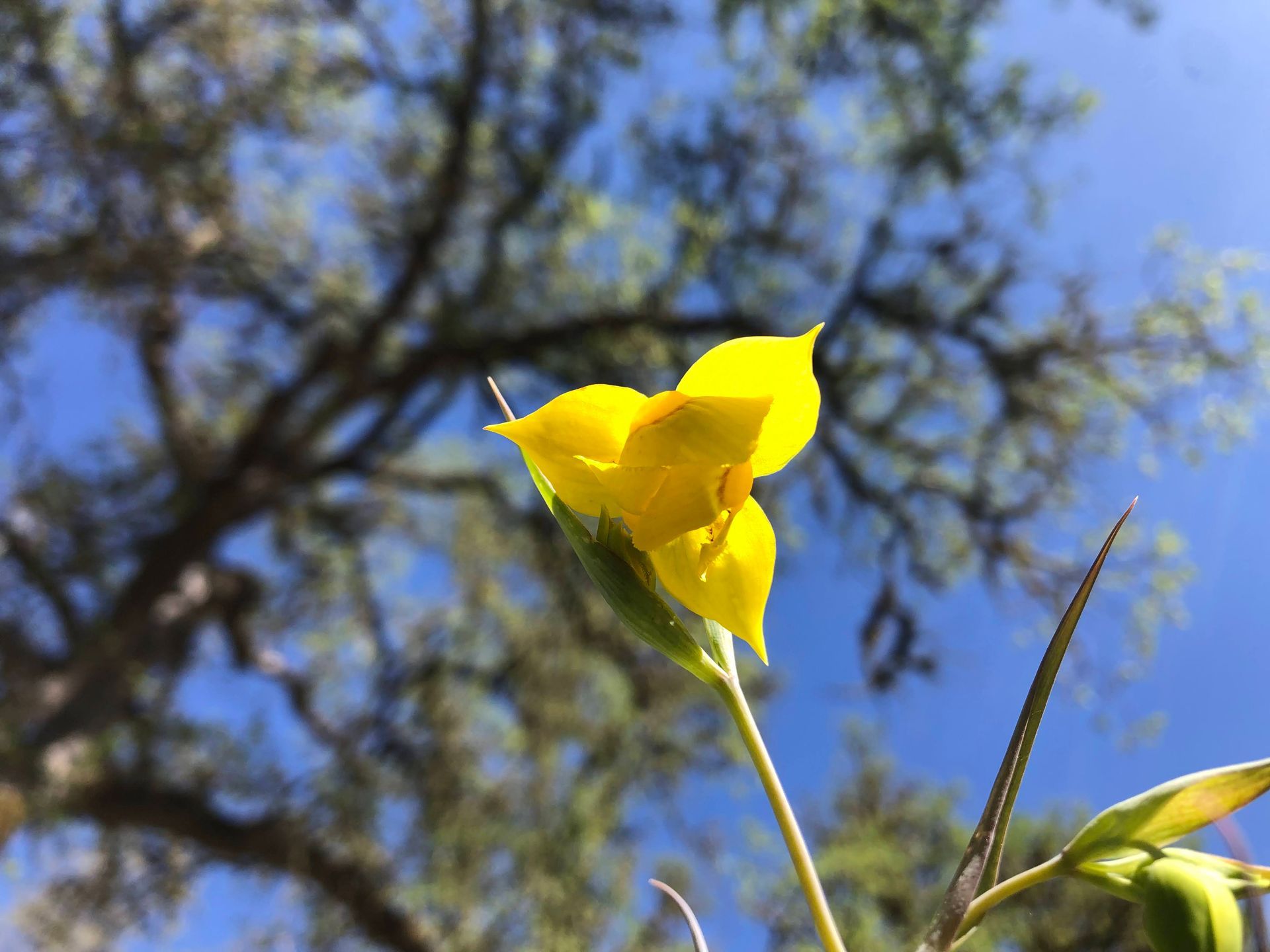Tuleyome's Science Corner: Wildflowers of Berryessa Snow Mountain National Monument

Looking up at a Golden Fairy Lantern (Calochortus amabilis)
If you have spent any time in the Berryessa Snow Mountain National Monument region recently, you will undoubtedly have seen many brilliant wildflowers. Like a lot of California, the Berryessa Snow Mountain area has a Mediterranean climate – typically cool, wet winters followed by hot, dry summers - which means that most of our wildflowers bloom January through May. Here is information about a few of the most eye-catching flowers.
Lupines may be the flower most recognizable from a distance or while driving through the Monument. Their shape is very distinctive – (usually) tall spires of flowers in a ring around the stem sticking up from leaves that look like fingers spread wide. The miniature lupine (Lupinus bicolor) however, is rather small and reminds you to slow down and take in your surroundings! Taking a look at the flowers of a lupine, it is easy to see that they are in the pea family. When the plant has gone to seed, the seed pods provide more proof as to lupines being legumes – the pods look like pea pods. The flowers come in many different colors, pale pink, light blue, dark blue, yellow.
Some of the most beautiful flowers are in the Calochortus genus, in the Lily family. The perennial flowers in this genus grow from a bulb and have 6 petals (actually tepals) in two series, and are different sizes. Close inspection of these flowers shows that some have “hairs” inside the petals, which are often used to distinguish some species, and that they are decorated with multiple colors and intricate patterns. Golden fairy lanterns (Colochortus amabilis) is noticeable because the flower hangs upside down!
Perhaps the most well-known California wildflower is the California Poppy (Eschscholzia californica). Hillside are often golden while these famous flowers are in bloom. These flowers are diurnal – they are most “active” during the day. The flowers will be closed in the morning then open as the sun shines on them and then close as the sun goes down! The tufted poppy or foothill poppy (Eschscholzia caespitosa) looks very similar but is slightly smaller (generally). To be sure of your identification, look where the petals meet the stem. If there is a ring, it is a California poppy, if not, it is a tufted poppy.
Paintbrushes, Castileja genus, can be overlooked but are none-the-less amazing flowers. These flowers are hemiparasitic which means that they obtain part of its nutriment from a host plant but also photosynthesize. Because of this, they are found near other plants – trees and shrubs to grasses and even other wildflowers like lupine. A flash of purple in a field of lupine is likely to be purple owls clover (Castilleja exserta). Paintbrushes and warrior’s plume (Pedicularis densiflora) are in the same family but different genera, despite having similar appearances and lifestyles.
California’s native bees have evolved with the State’s wildflowers and are most active January through May. Because the bees are most active during the spring and to beat out the hot, dry conditions to come, the native flowers seem to be competing as to which can be the most beautiful and therefore the most attractive to pollinators. We get to enjoy this competition!
Here is a list of flowers in these four genera that have been seen through the years on Tuleyome's wildflower tours into Bear Valley.
FABACEAE – pea family
Lupinus albifrons – silver bush lupine
Lupinus bicolor – miniature lupine
Lupinus micranthus – small-flowered lupine
Lupinus microcarpus var. densiflorus – yellow lupine
Lupinus microcarpus var. microcarpus – valley lupine
Lupinus nanus – sky lupine
Lupinus succulentus – arroyo lupine
LILIACEAE – lily family
Calochortus amabilis – golden fairy lantern
Calochortus luteus – golden mariposa lily
Calochortus splendens – splendid mariposa lily
Calochortus uniflorus– large-flowered star tulip
PAPAVERACEAE – poppy family
Eschscholzia caespitosa – small golden poppy; tufted poppy; foothill poppy
Eschscholzia californica – California poppy
Platystemon californicus – cream cups
OROBANCHACEAE - paintbrush family
Castilleja affinis – red paintbrush
Castilleja applegatei – round-leaved painbrush
Castilleja attenuata – valley tassels
Castilleja exserta – purple owl’s clover
Castilleja foliolosa – wooly paintbrush
-Nate Lillge; nlillge@tuleyome.org
Adventures and Engagement Director
Certified California Naturalist
RECENT ARTICLES






